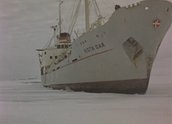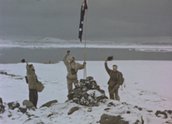


Blue Ice (1954)
Synopsis
Blue Ice documents the 1954 expedition to set up the first Australian base on the Antarctic continent. The chartered Danish ship Kista Dan leaves Melbourne in December 1953 under Captain Hans Christian Petersen, bound for Macquarie Island, to resupply the Australian base opened six years earlier. The ship then returns to Melbourne to refuel and take on supplies, departing in early January for the Australian base at Heard Island, 4000 kms away in the Indian Ocean. From there the ship heads south to Mac. Robertson Land, where the Australian expedition leader Phillip Law has selected a likely site for the Australian base. Close to the Antarctic Circle, the ship encounters heavy pack ice and must bash through, creating its own path to Horseshoe Bay, a protected harbour with exposed rock on the Antarctic coastline. The new channel through the ice attracts hungry Adélie penguins from their nearby rookery; they use the new path as a quick route to the sea and the food they need for their chicks.
When the ship becomes stuck fast in the ice, the crew and expedition members spend two days digging it out. Eventually, the Kista Dan arrives at the new site and work begins. With the sea frozen around the ship, unloading proceeds quickly, directly onto vehicles on the ice. New huts, prefabricated in Australia, spring up on the rocky coast. Work proceeds at a frenetic pace into the long Antarctic evening. Two Auster aircraft take off from the ice to begin aerial photography and reconnaissance of the nearby coast. As the new base becomes firmly established, the ship farewells the ten men who will live here for the next year; the first Australian group to winter on the ice in the modern era. Sailing further west, Phillip Law leads a party ashore at the Vestfold Hills, Prydz Bay, to survey the coast and plant the Australian flag. Six days later, after one of the worst storms an Australian ship has ever encountered, the Kista Dan breaks free and heads for home.
Curator’s notes
Blue Ice has a strong claim as the best of all the Australian Antarctic films. It is artfully made, historic, dramatic, entertaining and it gives a real sense of the extraordinary achievements of this voyage. It contains perhaps the most charming sequence of any Australian Antarctic film, in which hundreds of Adélie penguins use the channel created by the ship as a fast route to open water. It also contains extraordinary shots taken just in front of the bow by the expedition leader, Phillip Law, standing on the ice as the ship charges forward, trying to break through. This was typical of Law, who was sometimes brave to the point of being foolhardy in pursuit of his goals – a dangerous combination, according to some of his most trusted colleagues. These scenes don’t show that the captain of the ship was standing above, shouting at Law to get back on the ship, before the ice broke up around him. Indeed, what Blue Ice doesn’t show about this voyage is more dramatic than what it does. As good as it is, the film sheds light on the limits of government-sponsored filmmaking.
Phillip Law, director of the newly created Antarctic Division of the Department of External Affairs, had a keen understanding of the value of publicity. He shot most of the scenes we see here and many of the other films made during the 19 years that he ran the division. These films had multiple purposes, but telling the whole truth wasn’t one of them.
The real voyage was much more troubled and dangerous than the narration tells us. Between the landing at Vestfold Hills and the final scenes of the ship rolling alarmingly through perhaps 40°, the Kista Dan, on its first voyage to the Antarctic coast for the Australian Antarctic Division, survived a storm unlike anything anyone had seen before. The normally unflappable Phillip Law, who had made more than ten voyages south since 1947, wrote years later that he had never been so terrified. ‘Never have I experienced, either before or since, terror extending unrelieved over such a long period of time. I don’t think anyone on the ship really expected to survive and, over a period of 12 hours, each large roll seemed likely to be the last.’
The storm destroyed the one remaining Auster aircraft strapped to the boat deck (the other had been destroyed in an earlier storm). The crumpled and twisted wreckage was eventually swept completely off the deck by the 90-knot winds. The ship was light in the bows after being unloaded, which made it ride high in the water, and harder to control. The captain could not keep it facing into the wind; it broached and drifted helplessly before the wind. Dick Thompson, Law’s trusted second-in-command and a veteran of the Australian Navy who had seen plenty of difficult weather, wrote in his diary for 5 March 1954: ‘I have just spent the most horrible day of my life: terrifying would be an understatement.’ Kathleen Ralston, in the first of her two biographies of Phillip Law, writes that one of the ship’s engineers had a nervous breakdown and never went to sea again.
Relations between Law and Captain Petersen had reached a low ebb before the landing at Vestfold Hills. Like many expedition leaders before him, Law had clashed often with his captain about who was really in control. Law had foreseen this difficulty and made sure that the charter documents gave him as much power as possible. The captain could only disobey Law’s directions if he felt that the ship or its crew were in danger. Their disagreement over whether to turn south so late in the season to get to the Vestfold Hills went as far as cables to the ship’s owners in Denmark and the London offices of the Australian shipping company that had organised the charter. Law won. He was determined to land an Australian party at the Vestfold Hills, where only two previous landings had occurred. Law also wanted precise location data, with which to fix the positions of various landmarks (astrofixes). The captain wanted to turn north, away from the pack ice that had dogged much of the trip. Bad weather kept them at the Vestfold Hills longer than Petersen wanted. When they finally got away, they ran into this storm of a lifetime. Petersen stayed at the helm for 40 hours, without sleep. Ralston writes that when Law visited the bridge during the height of the storm, Petersen shouted at him: ‘Have you now got enough?’
Law’s feelings about his role were complicated. In large part, he felt that it was not his fault. The captain had delayed the ship for two days in the wrangle over whether they would visit the Vestfold Hills. If they had gone when Law wanted, they would have been out sooner. But he was later to admit to Tim Bowden, during an interview for Bowden’s history of ANARE, The Silence Calling: Australians in Antarctica, 1947–97 (1997), that he had felt some guilt. The following is from the raw transcript of the interview, when Law is talking about this storm.
Law: Meanwhile, the captain has no steerage. All he can do as we are drifting down on icebergs is to go either forward or astern, so he’s crabbing around obstacles with his four-door stern manoeuvre and this went on for 26 hours, and the other danger was we were drifting across the bay and on the other side of the bay there were the ice cliffs of the Amery Ice Shelf … so if he hit those we’d be in trouble too … Altogether it was a pretty desperate occasion and all through it, I knew it was my fault.
Bowden: Did the captain say anything?
Law: I had forced the captain into that situation.
Law’s words make clear that the ship was out of control during the worst of the storm. It could have been rolled by the wind or smashed against an iceberg, and rescue was impossible. Everyone on board knew that they were lucky to survive. From the same interview:
Bowden: That was the moment when you were most frightened … what about … was that the most hazardous moment in a ship that you had down there?
Law: Yes. It’s interesting that no-one on that ship took a photograph during that period … Not I even … who was the official photographer because we all knew we were going to die and there wasn’t point in taking photos.
The film’s final narration gives very little sense of what they had been through. The first Antarctic voyage of the Kista Dan was an outstanding success, and that’s the story told in Blue Ice. There is just a hint that it could have been otherwise (see clip three).
In 1955, Blue Ice won a Kodak Cup for the best Kodachrome documentary film, in the Fourth International Festival of Films on Mountaineering and Exploration in Trento, Italy.
- Overview
- Curator’s notes
- Video 3 clips
- Principal credits
- Find a copy
- Comments 2
- Map
- Add your review



